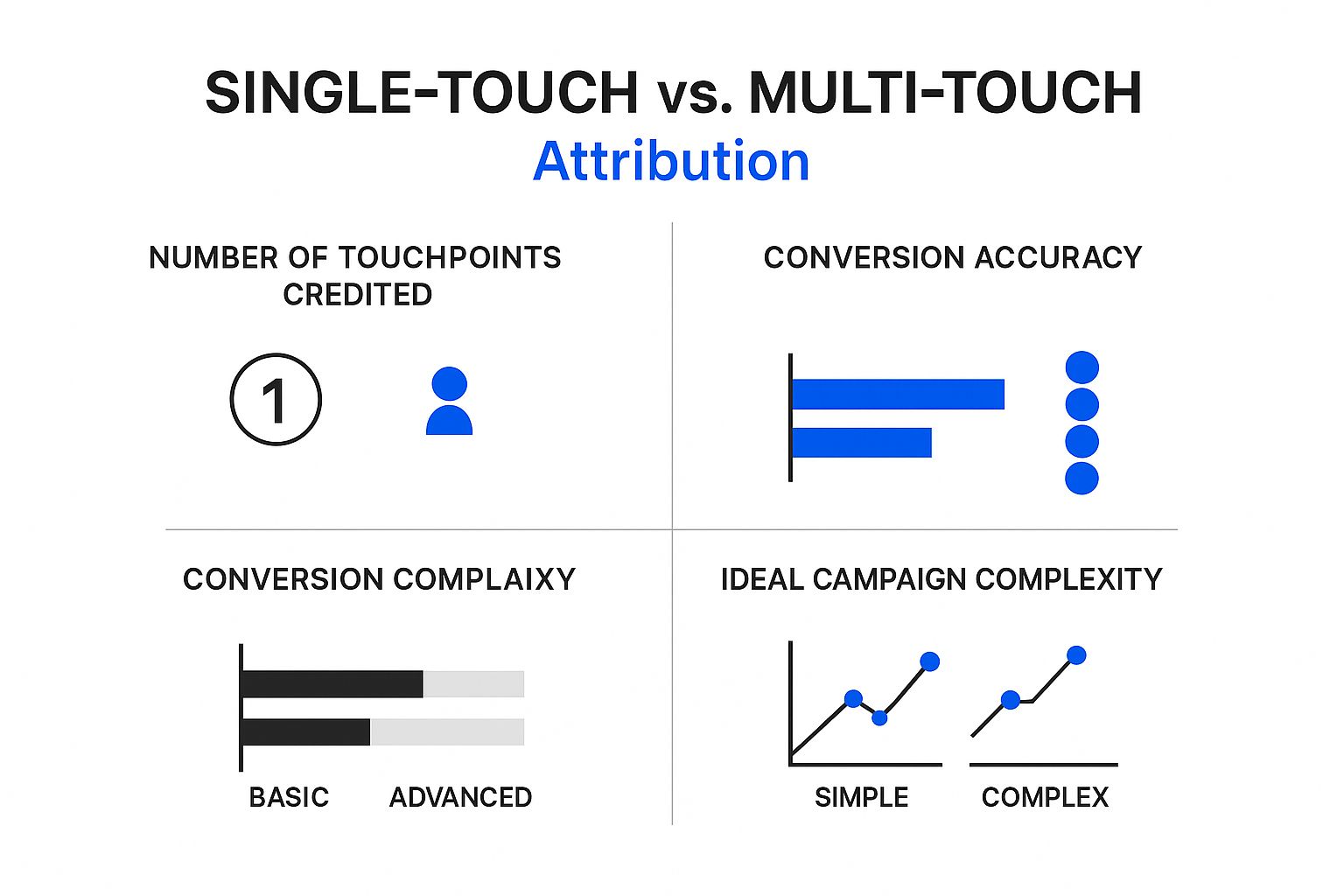Marketing attribution is how you figure out which of your marketing efforts are actually making a difference. It’s the playbook that connects the dots between a customer seeing your ad and finally making a purchase.
Think of it like a detective solving a case. The final purchase is the crime scene, but what clues led the customer there? Marketing attribution helps you trace back every step—the social media ad they saw, the blog post they read, the email they opened—to see what truly influenced their decision.

Let's imagine a typical customer journey. A potential buyer first stumbles upon your brand through a Facebook ad. A few days later, they search for you on Google. The following week, they click a link in your newsletter and, finally, they buy after seeing a retargeting ad. So, which touchpoint gets the credit?
Without a proper attribution model, most businesses would give 100% of the credit to the last click—that retargeting ad. This is a huge mistake. It completely ignores the crucial roles the Facebook ad and the email newsletter played in building awareness and keeping your brand top-of-mind.
Attribution helps you move beyond that simplistic, last-click view. It gives you a framework to distribute credit across all the touchpoints that nudged the customer along, painting a far more accurate picture of what's driving sales.
Today's customer journey isn't a straight line; it's a tangled web. People jump from their phone to their laptop, scroll through social media, read reviews, and watch videos before they even think about buying. This messy reality makes old-school measurement not just outdated, but dangerously misleading.
Getting attribution right helps you:
The real goal of marketing attribution isn't just to look back at what happened. It's about gaining the foresight to build a more profitable future. It transforms marketing from a cost center into a predictable, data-driven growth engine.
This hunger for clarity is fueling massive investment in the right tools. The global marketing attribution software market was valued at around USD 4.74 billion and is expected to grow at a compound annual growth rate (CAGR) of 13.6% from 2025 through 2030.
This isn't just a trend; it's a fundamental shift in how businesses operate. Companies are moving away from guesswork and gut feelings toward decisions backed by solid data. You can discover more insights on the rapid expansion of attribution platforms and see what’s pushing the market forward.
Ultimately, marketing attribution is about making smarter decisions. It's the difference between flying blind and having a GPS that guides every single dollar you spend. Once you understand what’s really contributing to your success, you can stop guessing, prove your impact, and build a much more powerful marketing machine.
Picking a marketing attribution model is a lot like choosing a camera lens. Some are simple point-and-shoots that only see the last thing that happened, while others are wide-angle lenses that capture the entire customer journey. The model you choose determines how you assign credit for a sale, which directly shapes where you invest your marketing budget.
There’s no single “right” answer here. It’s about picking the framework that best mirrors how your customers actually behave and aligns with your business goals. Let's walk through the most common models, starting with the simplest and working our way up to the more insightful ones.
Single-touch models are the most straightforward approach to marketing attribution. They give 100% of the credit for a conversion to just one touchpoint. While they're incredibly easy to set up, they often paint a narrow and sometimes misleading picture of what’s really working.
Think of it like a soccer game. A single-touch model gives all the glory to the player who scored the goal, completely ignoring the midfielders who passed the ball and the defenders who started the entire play.
There are two main types:
Despite their obvious flaws, these models are still surprisingly common. Research has shown that only about 52% of marketers were using marketing attribution reporting at all. The most prevalent method remains the last-click model, which is used by 41% of marketers.
The infographic below does a great job of comparing single-touch and multi-touch models, showing how they differ in both complexity and accuracy.

As you can see, multi-touch models give you a far more accurate and advanced view of performance, which is especially critical for businesses with longer sales cycles and more complex campaigns.
Multi-touch models are built on the reality that a conversion is almost never the result of a single interaction. Instead, they distribute credit across multiple touchpoints, giving you a much richer, more balanced view of your entire marketing ecosystem. These models let you see the full team effort, not just the final goal.
A multi-touch approach stops you from mistakenly cutting the budget for a blog post that introduces hundreds of new customers, just because it wasn't the last thing they clicked before buying.
Here’s a look at the most popular multi-touch models:
To help you decide, the table below breaks down how each of these models works and where they shine.
This table compares common attribution models, showing how each assigns credit and highlighting their primary pros and cons to help marketers choose the right one.
Attribution ModelHow It WorksBest ForPotential DrawbackFirst-ClickGives 100% credit to the first touchpoint.Understanding top-of-funnel channels that drive initial awareness.Ignores all other interactions that influence the final decision.Last-ClickGives 100% credit to the final touchpoint before conversion.Identifying bottom-of-funnel channels that are effective at closing deals.Devalues channels that build interest and nurture leads over time.LinearDistributes credit equally across all touchpoints in the journey.Businesses with long sales cycles where every interaction is considered valuable.Can overvalue minor touchpoints and undervalue major ones.Time-DecayGives more credit to touchpoints closer to the conversion time.Short promotional campaigns or businesses where recent interactions matter most.Underestimates the impact of early-stage, awareness-building efforts.U-ShapedGives 40% credit to the first touch, 40% to the last, and 20% to the middle.Valuing both the initial lead source and the final conversion driver.May not give enough credit to important mid-funnel nurturing steps.
Ultimately, choosing the right model comes down to your business. A company with a short sales cycle, like an e-commerce store selling low-cost items, might do just fine with a Last-Click or Time-Decay model. On the other hand, a B2B SaaS company with a six-month sales cycle involving demos, whitepapers, and sales calls will get far more accurate insights from a U-Shaped or Linear model. For a deeper dive, check out our complete guide on different marketing attribution models.
The key is to pick a model that truly reflects the complexity and length of your typical customer journey.

Let's move beyond the theory. A smart attribution strategy delivers real-world results that hit your bottom line, plain and simple. It’s not about collecting data for the sake of it; it's about turning that data into more intelligent, profitable decisions. The true power of marketing attribution is the clarity it brings, transforming your team from one that just spends a budget to one that strategically invests it.
One of the first things you'll notice is the ability to optimize your marketing spend with total confidence. Without attribution, you might see a lot of clicks and engagement from your social media channels and assume they're working wonders. But what if an attribution model revealed your email campaigns were quietly driving 80% of your high-value sales? That's an insight you can act on immediately, shifting budget from channels that look busy to those that are proven to deliver revenue.
Great attribution gives you a clear map of the entire customer journey, not just the last click. You start to see the powerful combinations of touchpoints that guide someone from being a curious browser to a loyal customer. For instance, you might discover that your most valuable customers are the ones who first read a blog post, then see a retargeting ad, and finally click an email link.
This level of detail unlocks smarter personalization. Instead of blasting everyone with the same generic message, you can tailor your approach based on where someone is in their journey.
Understanding these paths is absolutely critical, as our guide on https://www.cometly.com/post/how-to-measure-marketing-attribution explains in greater detail. This knowledge empowers you to deliver the right message at the perfect moment, which can dramatically lift conversion rates and build much stronger customer relationships.
Here’s the big one: attribution gives you the power to definitively prove marketing’s return on investment (ROI). For far too long, marketing departments have struggled to connect their efforts directly to sales, often relying on softer metrics like "brand awareness" or "engagement." An attribution strategy changes that conversation completely.
With attribution data, you can walk into any budget meeting and say, "For every dollar we invested in our Google Ads campaign, we generated five dollars in revenue." This is the kind of hard data that builds credibility and secures the resources your team needs to grow.
Ultimately, learning how to measure marketing ROI is one of the most powerful outcomes of a solid attribution strategy. By assigning clear value to each touchpoint, you can justify your spending, showcase your team’s impact, and earn the respect you deserve. This transforms marketing from a perceived cost center into a documented, predictable driver of business growth.
Moving from theory to practice can feel like a massive jump, but a step-by-step approach makes implementing marketing attribution completely manageable. Think of this plan like building a house. You wouldn’t just start hammering without a blueprint, right? This five-step process is your blueprint for turning raw data into an engine for smarter decisions.
It all begins with knowing what you’re building toward. Without a clear destination, any map is useless. That’s why the first and most critical step is defining what a "win" actually looks like for your business.
Before you can track a single click, you have to define your key conversion goals. These are the specific, valuable actions you want users to take on their journey. Remember, a conversion isn't always a final sale; it can be any milestone that moves someone closer to becoming a customer.
Your goals will be unique to your business. For example:
Define both macro-conversions (the ultimate goal, like a purchase) and micro-conversions (smaller steps, like a newsletter sign-up). This gives you a much richer view of the entire customer journey, not just the finish line.
Once your goals are set, it’s time to map out all the potential ways a customer can interact with your brand. This is your chance to identify every digital and offline "touchpoint" that could influence a decision. Your list might be longer than you think.
Common touchpoints to consider include:
The goal here is to be exhaustive. You need to make sure your tracking tools are set up to capture data from as many of these sources as possible. Missing even one key touchpoint can skew your entire analysis and lead you to the wrong conclusions.
Now you can circle back to the attribution models we discussed earlier and pick the one that actually fits your business. There’s no single "best" model; the right choice depends entirely on your sales cycle and customer behavior.
Ask yourself these questions:
Start simple. You can always begin with a model like Linear in Google Analytics and evolve as you gather more data and get more comfortable with the process.
You have a wide array of tools at your disposal, from free platforms to advanced, dedicated software. The right tool depends on your budget, technical resources, and the complexity of your marketing stack.
Here’s a breakdown of the common options:
Tool CategoryExamplesBest ForPlatform-Native AnalyticsGoogle Ads, Facebook Ads ManagerBasic, channel-specific reporting. Good for a quick look but very siloed.Web Analytics PlatformsGoogle Analytics 4, MatomoComparing channels and applying basic multi-touch models (Linear, First-Click, Last-Click).Dedicated Attribution PlatformsCometly, HubSpot, Ruler AnalyticsBusinesses needing to unify data from multiple sources, track complex journeys, and get a single source of truth.
Platforms like Google Analytics are a fantastic starting point. As your marketing grows, however, a dedicated tool becomes essential for connecting all the dots and getting an accurate picture of what's really happening.
Finally, marketing attribution is not a "set it and forget it" task. It’s an ongoing cycle of analysis, insight, and optimization. Once your system is up and running, block off time to regularly review your reports and hunt for patterns.
Your focus should be on answering critical business questions:
Use these insights to form a hypothesis, run a test (like shifting budget from a low-performer to a high-performer), and measure the results. This continuous loop of refinement is where the real value of marketing attribution is unlocked, turning your strategy from reactive to proactively data-driven.
So, you're ready to dive into marketing attribution. That's a huge step forward, but let's be honest—it's rarely a simple plug-and-play process. Getting to that crystal-clear, actionable data usually means tackling a few common (but significant) hurdles first.
Knowing what roadblocks to expect is half the battle. Think of it as building a measurement system that’s not just powerful, but resilient enough to handle the messy reality of modern marketing.
One of the first headaches you'll encounter is fragmented data. Your customer information is probably scattered across a dozen different systems: your ad platforms, CRM, email provider, and website analytics. Each one holds a piece of the puzzle, but getting them all to talk to each other and tell a single, coherent story? That can be a monster of a technical challenge.
The modern customer journey is anything but linear. Someone might see your ad on their phone during their morning commute, browse your site on their work laptop, and finally pull the trigger and buy from their tablet at home. This cross-device behavior creates huge gaps in tracking, making it nearly impossible to connect the dots.
This is exactly why a unified tracking approach is non-negotiable. To truly map the customer path, you have to stitch these disparate data points together. This usually involves:
Solving this puzzle is the bedrock of accurate attribution. Without a unified view, you're flying blind, making big decisions based on an incomplete and potentially misleading picture. Our guide on the importance of attribution models in marketing digs deeper into why this complete view is so critical.
Beyond the technical stuff, the ground is literally shifting under our feet thanks to new privacy regulations. Rules like GDPR and the slow death of third-party cookies have fundamentally changed how we can collect and use customer data. The old ways of tracking just aren't as reliable anymore.
With browsers cracking down and regulations tightening, marketers are finding it harder to track users. This shift has pushed savvy teams toward AI-driven attribution tools and real-time analytics just to stay in the game. You can explore future trends in marketing attribution to see how the industry is adapting. A future-proof strategy has to put first-party data—the information customers willingly share with you—at the center of everything.
Building a strong first-party data strategy isn't just about staying compliant; it's a massive competitive advantage. It lets you build real relationships with your audience based on trust, all while fueling more accurate attribution.
Finally, don't underestimate the challenge of getting your own organization on board. Moving from a simple last-click mindset to a more nuanced multi-touch approach requires educating and aligning different teams. You'll need to clearly show how accurate attribution benefits everyone—from the marketing team proving its value to the finance team seeing a much clearer ROI on every dollar spent.

Let’s bring this all together. At the end of the day, effective marketing attribution isn’t about finding a single, perfect answer. It’s about committing to a cycle of continuous improvement—asking better questions and making smarter, incremental adjustments over time. The goal isn't a flawless final report; it's progress.
Don't let the complexity stop you from starting. The journey toward data-driven decisions begins with one small step. You don't need a sophisticated multi-touch model on day one to start seeing real value.
Begin with a simple comparison. Pull up your standard last-click report in Google Analytics, then flip the view to a linear model. What just changed? Which channels suddenly look more valuable? This one exercise can spark powerful conversations and reveal opportunities you’ve been missing in your marketing mix.
From there, you can build your capabilities piece by piece. As your confidence grows, you can explore more advanced models, pull in more data sources, and fine-tune your tracking. The key is just to get moving.
Empowerment is the ultimate takeaway. By committing to understanding what truly works, you replace guesswork with strategy, turning your marketing efforts into a predictable engine for business growth.
You have the framework to get started. The only thing left is to take action. A solid attribution strategy creates a clear line of sight from your marketing activities directly to your bottom line. To see how this powerful connection works in practice, check out our guide on closed-loop attribution.
You now have a roadmap to stop guessing and start making decisions that drive real, measurable results. Your journey toward smarter marketing begins today.
Even with a clear roadmap, it's natural to have questions when you're diving into attribution. Let's tackle some of the most common ones that come up as businesses start to get serious about measurement.
Think of marketing analytics as your car's entire dashboard. It's the big picture—it shows your speed (traffic), fuel level (budget), and engine health (overall site performance). Analytics gives you a broad overview of everything that’s happening with your marketing.
Marketing attribution, on the other hand, is a specialized part of that dashboard. It’s the GPS that shows you the exact route someone took to get to their destination. Attribution zooms in to assign credit to the specific touchpoints that guided a customer to a conversion, answering the crucial question, "Which of my efforts actually made this sale happen?"
When you're just getting started, simplicity is your best friend. A Last-Click or Linear model is a fantastic place to begin.
The goal isn't to be perfect on day one. It's about starting with a simple model, learning from the data you collect, and then graduating to more sophisticated models as your business and marketing strategy grow.
This is a big one. If you're ignoring what happens offline, you're only seeing half the story. Connecting your digital campaigns to real-world actions like phone calls or store visits is essential for getting a true read on your marketing ROI.
Ignoring offline conversions means you're only seeing part of the customer journey. Integrating these touchpoints is essential for accurate marketing attribution and understanding the true ROI of your campaigns.
For phone calls, you can use call tracking software that assigns a unique phone number to each campaign, letting you trace every ring back to its source. To track in-store visits, you might use unique coupon codes from a digital ad or link loyalty program sign-ups to a specific campaign.
But the most powerful method is to integrate your CRM directly with your analytics platform. This allows you to directly connect a user's online journey with their offline purchase, closing the loop once and for all.
Ready to stop guessing and start seeing exactly what drives your growth? Cometly provides a single source of truth for all your marketing efforts, unifying your data and delivering the clear insights you need to optimize every dollar you spend. Get your free trial of Cometly today!
Learn how Cometly can help you pinpoint channels driving revenue.
.svg)
Network with the top performance marketers in the industry